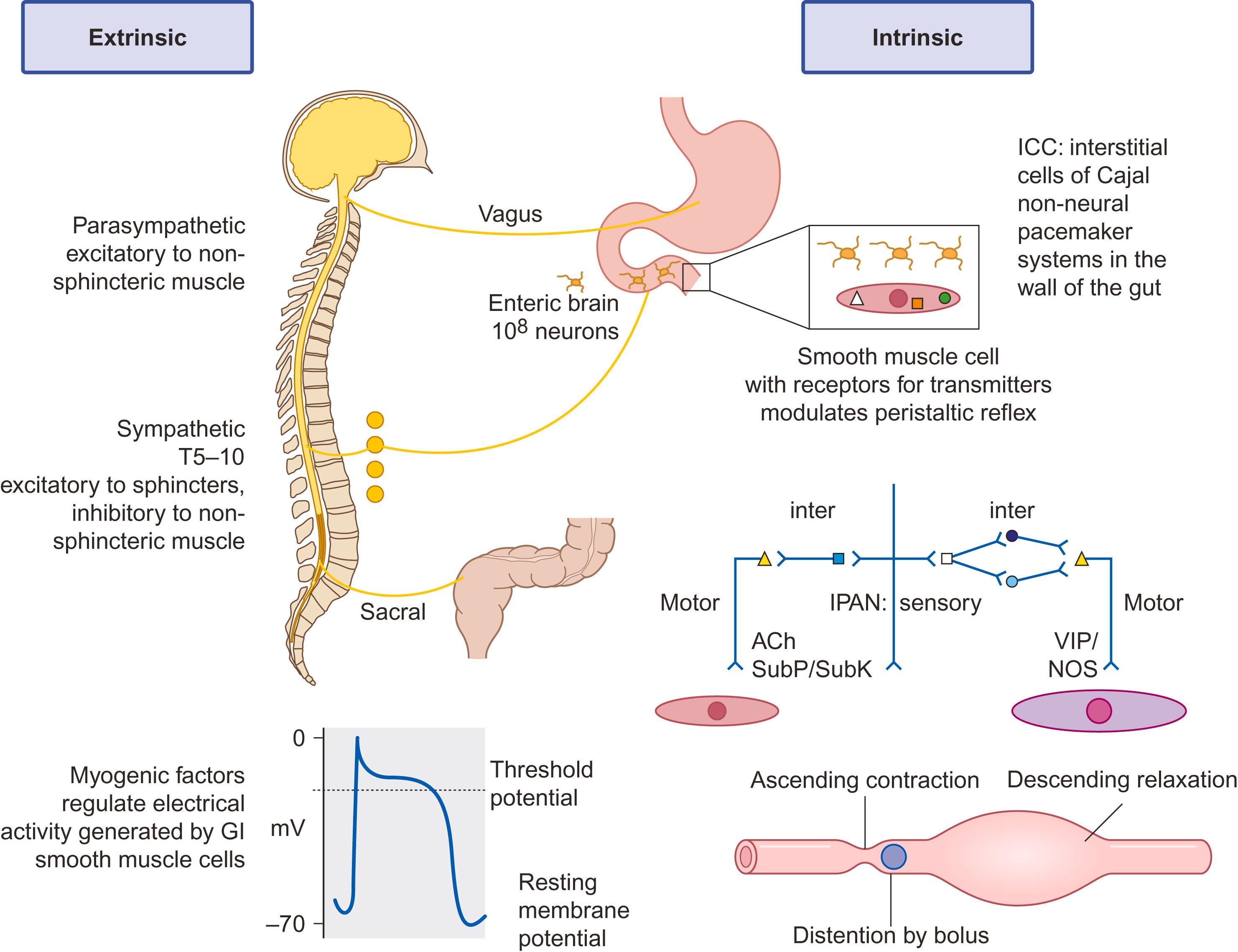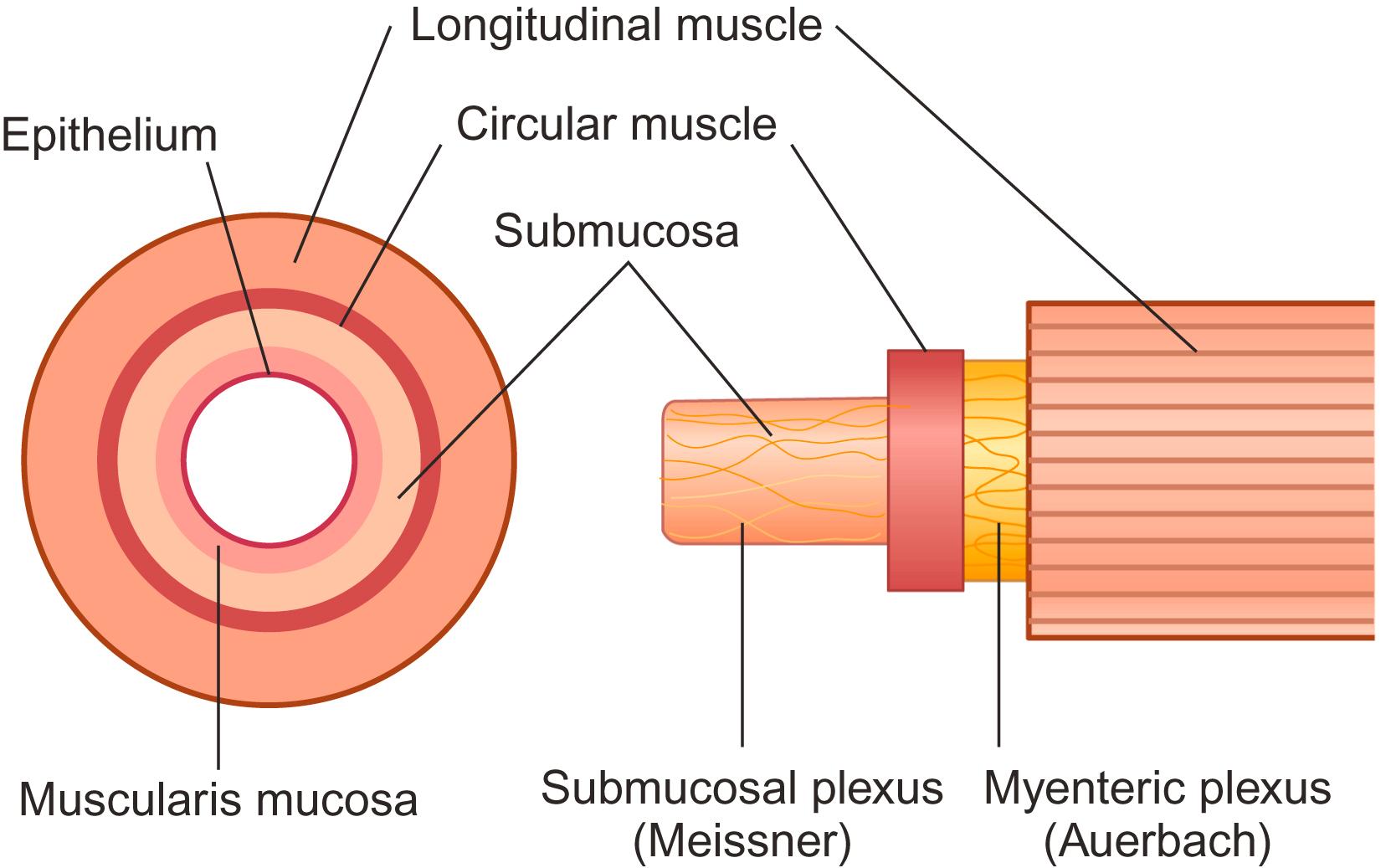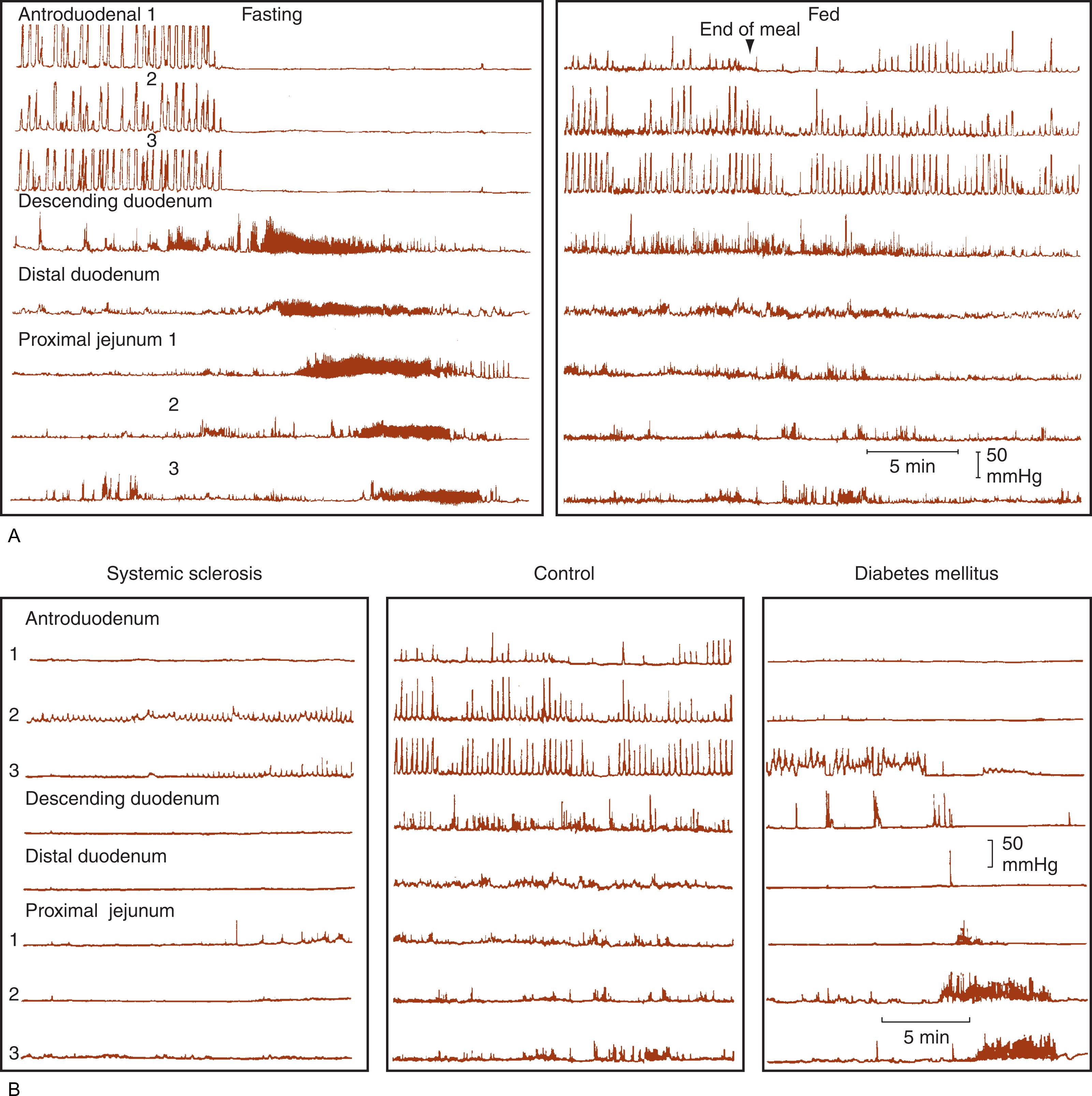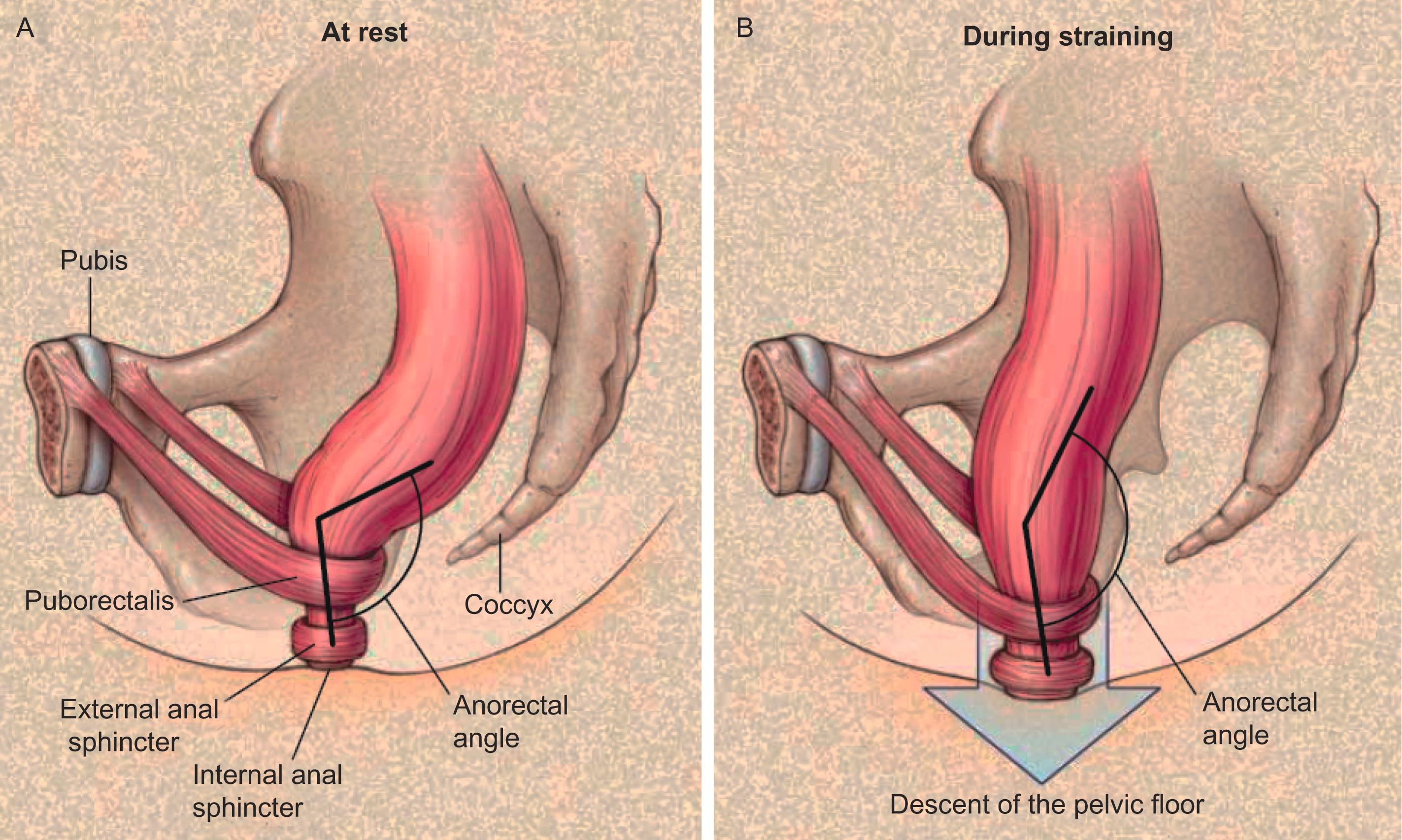Physical Address
304 North Cardinal St.
Dorchester Center, MA 02124
The major functions of the gastrointestinal tract (motor, fluid and electrolyte transport, secretory, storage, and excretory functions) result from an intricately balanced series of control mechanisms ( Fig. 14-1 ): the electrical and contractile properties of the smooth muscle cell that result from transmembrane fluxes of ions. Control is by the enteric nervous system through chemical transmitters such as acetylcholine, biogenic amines such as serotonin, neuropeptides released within the gut, and nitric oxide. These transmitters may act as circulating hormones or at the site of release (paracrine or neurocrine function). Regulation by extrinsic pathways (sympathetic and parasympathetic nervous systems) modifies the functions that are intrinsically controlled by the enteric mechanisms. Disorders of the nervous system affecting gastrointestinal tract function are manifested primarily as abnormalities in motor (rather than sensory, absorptive, or secretory) functions of the gut.

In the mammalian digestive tract, the intrinsic (or enteric) nervous system (ENS) contains about 100 million neurons, approximately the number present in the spinal cord. This integrative system is organized in ganglionated plexuses ( Fig. 14-2 ), which include the interstitial cells of Cajal (positive for ckit or tyrosine kinase) and fibroblast-like cells (positive for platelet-derived growth factor receptor α [PDGFRα]). Together, these cells constitute the electrical syncytium or the gastrointestinal pacemakers, integrating neuromuscular activity controlled by the ENS. The ENS is distinct and separate from the autonomic nervous system. It has several components: sensory mechanoreceptors and chemoreceptors, interneurons that process sensory input and control effector (motor and sensory) units, and effector secretor or motor neurons involved in secretory or motor functions of the gut.

Neural tissue in the gastrointestinal tract consists of nerve cell bodies and plexuses found in classically recognized plexuses, including the myenteric (Auerbach) plexus between the two muscular layers of the muscularis externa, and the submucosal (Meissner) plexus.
The myenteric plexus contains a large number of closely spaced ganglia interlinked by nerve-fiber bundles and extending from the pharyngoesophageal junction to the internal anal sphincter. Each ganglion contains a variable number of nerve cell bodies (up to 100). The submucosal plexus is confined to the small and large intestines and is composed of either large or small ganglia that are interlinked by internodal strands containing hundreds of axons.
Preprogrammed neural circuits integrate motor function within and between different regions to coordinate gut functions. These functions include the peristaltic reflex and the interdigestive migrating motor complex ( Fig. 14-1 ). The synaptic pathways in the gut wall respond to sensory input (e.g., by intraluminal content), and they can also be modulated by vagal and sacral (S2–4) preganglionic fibers (generally excitatory), and by sympathetic (T5–L2) postganglionic nerves (generally inhibitory to muscle layers, and excitatory to sphincters). There are approximately 40,000 preganglionic vagal fibers (many of which are afferent) at the level of the diaphragm. Loss of the sympathetic inhibitory control (“the brake”) may manifest with gut motor overactivity, including diarrhea. Table 14-1 summarizes the wiring and functions of the extrinsic neural pathways to the digestive tract.
| Parasympathetic | Sympathetic | ||||
|---|---|---|---|---|---|
| Region | Wiring | Function | Wiring | Function | Central Mechanism |
| Esophagus | |||||
| Cervical | Vagus nerve; Recurrent laryngeal branch | Peristalsis in response to burst of spike activity | Superior cervical ganglion | Stimulation of UES tone | Motor: nucleus ambiguus, corticobulbar pathways |
| Glossopharyngeal and vagus nerve | Sensation | Sensory: nucleus of tractus solitarius | |||
| Thoracic | Vagus nerve | Peristalsis by successive firing of vagal fibers | Celiac ganglion T6–9 spinal cord | Stimulation of LES tone | Motor: dorsal motor nucleus of vagus, corticobulbar pathways Swallowing : afferent modulation of central program |
| Vagus nerve to nodose ganglia | Sensation | ||||
| Stomach | Vagus nerve | Peristalsis (cholinergic), inhibitory (nonadrenergic, e.g., receptive relaxation) | Celiac ganglion T6–9 spinal cord | Inhibition and relaxation (e.g., antrofundal reflex) | Motor and sensory: Dorsal motor nucleus of vagus, thoracic spinal cord; nucleus ambiguus |
| Vagus nerve | Stretch and chemosensation | Spinal root ganglia T7–11 | Mechanosensation (e.g., gastrogastric or enterogastric distention or nutrient reflexes) | ||
| Small and large intestines | Vagus nerve | Small bowel and proximal colon peristalsis and sensation | Celiac ganglion to duodenum; superior and inferior mesenteric ganglia via splanchnic nerves to small bowel and via lumbar colonic nerves to colon; T9–10 spinal cord | Motor inhibition; distention reflexes | Nucleus of tractus solitarius ( sensory ), dorsal motor nucleus of vagus ( sensory and motor ); thoracic spinal cord; spinal cord base of dorsal horn ( motor parasympathetic ); parasympathetic nucleus ( sensory ) |
| Sacral S2–4 | Distal colon peristalsis and sensation | ||||
| Ileocecal sphincter | Vagus nerve | Sphincter contraction | Splanchnic and lumbar colonic nerves | Sphincter contraction (α effect); possibly also inhibitory β effect | T9–10 spinal cord; vagal nucleus ( motor ) |
| Anal sphincter | |||||
| Internal | S2–4 | Sphincter relaxation | Lumbar splanchnic nerves; inferior mesenteric ganglia via hypogastric nerves | Sphincter contraction (α effect); possibly inhibitory β effect; ? participates in rectoanal inhibitory reflex; mediation of vesico-anal reflex | T9–10 spinal cord; spinal cord base of dorsal horn ( parasympathetic ) |
| External | S2–4 via pudendal nerves | Voluntary control; sensation | Lateral part of ventral horn of spinal cord ( motor and sensory ) | ||
There are four layers (mucosa, submucosa, muscularis, and serosa) in the gut, with neural components between several layers. The mucosa is responsible for digestion and absorption and consists of the surface epithelium and the lamina propria. It is separated from the submucosa by the specialized, circumferential muscularis mucosae, which functions to allow surface absorptive cells to be in close contact with the intraluminal content. The submucosa consists of connective, lymphatic, and vascular tissue. The muscularis propria (or externa) is composed of an inner, thicker circular layer and an outer, thinner longitudinal layer. The longitudinal layer covers the entire circumference in the esophagus, small intestine, and rectum; in the colon, it is separated into three taeniae coli. In addition to these two layers, the stomach has a third oblique smooth muscle layer. The spindle-shaped smooth muscle cells are 40–100 μm long and 2–8 μm in diameter and are tightly packed with little connective tissue and with special contacts to allow for electrical coupling with the electrical syncytium . The gap junctions between the smooth muscle cells are essential, allowing sheets of muscle to be controlled by a few cells at the nerve–muscle interface. The serosa, which is the outermost layer, is composed of a thin sheet of mesothelial cells and connective tissue.
The literature on this topic is extensive. Older reference citations for specific statements made in this chapter can be found in prior editions.
Dysphagia is the sensation of difficulty in swallowing. Oropharyngeal, or transfer, dysphagia is the inability to initiate a swallow or propel food from the mouth to the esophagus. The hold-up occurs high in the pharynx or esophagus and generally results from neurologic lesions affecting the swallow pathway rather than from a process affecting the oropharyngeal mucosa. Stroke and Parkinson disease are common causes; less commonly, other brainstem diseases (e.g., bulbar polio, Arnold–Chiari malformations, tumors) or muscle diseases (e.g., dystrophies and mitochondrial cytopathies) are responsible. Esophageal dysphagia is caused by abnormal esophageal peristalsis unrelated to the extrinsic neural supply, or to smooth muscle disorders (e.g., polymyositis).
Neuromuscular dysphagia typically results in dysphagia to both liquids and solids, and aspiration into the upper airways.
Physical examination shows evidence of the co-existing neurologic disease, such as abnormal palatal or pharyngeal movements or a brisk jaw jerk, suggesting pseudobulbar palsy. Barium videofluoroscopy or a fiberoptic endoscopic evaluation of swallowing can identify the motor and sensory disturbances, and may help stratify the risk of aspiration in patients with pharyngeal weakness. Pharyngoesophageal motility studies using solid-state pressure transducers also complement the diagnosis. Re-education of the swallowing process is feasible in many patients, often in a program that incorporates speech therapy. Nutritional support and prevention of bronchial aspiration are essential for those with more severe dysphagia not responding to conservative measures. This may require a gastrostomy feeding tube, which facilitates discharge from hospital, physical therapy, and rehabilitation. Since swallowing may improve considerably in the first 2 weeks after a stroke, long-term decisions should be delayed for that period.
Gastric motor dysfunction resulting in delayed gastric emptying is a common gastrointestinal manifestation of autonomic neuropathies, such as those associated with diabetes mellitus, surgical vagotomy (e.g., laparoscopic fundoplication), and numerous medications, most commonly narcotic analgesics, tricyclic antidepressants, and dopamine agonists. Typical symptoms are recurrent postprandial nausea, emesis, and bloating, and pain resulting in weight loss and malnutrition. In diabetes mellitus, delayed gastric emptying may often be asymptomatic. Other stomach dysfunctions such as impaired gastric accommodation or gastric hypersensitivity may contribute to symptoms of gastroparesis (e.g., in diabetic patients). There may be a succussion splash on physical examination. It is essential to exclude gastric outlet obstruction by imaging the stomach or by endoscopy. Scintigraphic or stable isotope gastric emptying tests confirm delayed gastric emptying. Gastric stasis in neurologic diseases may result from abnormal motility of the stomach or small bowel; studies of pressure profiles by manometry or solid-state pressure transducers ( Fig. 14-3 A ) are rarely required to differentiate neuropathic from myopathic processes ( Fig. 14-3 B ). Gastroparesis management includes the use of prokinetic agents, antiemetics, nutritional support, and interventions such as laparoscopic or endoscopic pyloroplasty.

Chronic intestinal pseudo-obstruction is a syndrome characterized by nausea, vomiting, early satiety, abdominal discomfort, weight loss, and altered bowel movements suggestive of intestinal obstruction in the absence of a mechanical obstruction. These symptoms are the consequence of abnormal intestinal motility, including from neurologic diseases extrinsic to the gut (e.g., disorders at any level of the neural axis), dysfunction of neurons in the myenteric plexus, or degeneration or malfunction of gut smooth muscle ( Table 14-2 ). Use of narcotics, phenothiazines, dopaminergic agents, antihypertensive agents such as clonidine, and tricyclic antidepressants having anticholinergic effects may cause intestinal or colonic dysmotility.
| Cause | Myopathic | Neuropathic |
|---|---|---|
| Infiltrative | Progressive systemic sclerosis (PSS) | Early PSS |
| Amyloidosis | ||
| Amyloidosis | ||
| Familial | Familial visceral myopathies, including metabolic myopathies | Familial visceral neuropathies |
| General neurologic diseases | Myotonic and other dystrophies | Diabetes mellitus Porphyria |
| Mitochondrial cytopathies | Heavy metal poisoning | |
| Brainstem tumor | ||
| Parkinson disease | ||
| Multiple sclerosis | ||
| Spinal cord transection | ||
| Infectious | Chagas disease | |
| Cytomegalovirus infection | ||
| Drug-induced | Tricyclic antidepressants | |
| Narcotic bowel syndrome | ||
| Neoplastic | Paraneoplastic (bronchial small cell carcinoma or carcinoid) | |
| Idiopathic | Hollow visceral myopathy | Chronic intestinal pseudo-obstruction (possibly myenteric plexopathy) |
The clinical features may suggest an underlying disease process. For example, postural dizziness, difficulties in visual accommodation in bright lights, sweating abnormalities, recurrent urinary infections, and problems with bladder voiding suggest an autonomic neuropathy. However, urinary manifestations are more commonly the result of the pelvic floor dysfunction that accompanies constipation, independent of any neurologic disease. Examination should evaluate pupillary reflexes to light and accommodation and the blood pressure and pulse in lying and standing positions; referral for autonomic reflex evaluation is important.
The combination of external ophthalmoplegia, high dysphagia, peripheral neuromyopathy (e.g., increased serum creatine kinase) and acidosis (e.g., increased lactate, pyruvate) suggests mitochondrial cytopathy, a rare disorder associated with small bowel pseudo-obstruction and diverticulosis.
Plain radiographs and barium follow-through or computed tomographic (CT) or magnetic resonance (MR) enterography usually show nonspecific findings; dilatation of the small intestine is more frequent in later stages of myopathic than neuropathic disorders. The presence of small intestinal diverticula in a patient under 40 years should raise suspicion for mitochondrial cytopathy. Motility studies ( Fig. 14-3 ) help differentiate myopathic and neuropathic processes. When a neuropathic process is identified, autonomic, radiologic, and serologic tests should be performed to identify the cause of the autonomic neuropathy or cerebrospinal disease (see later).
The goals of treatment of chronic intestinal pseudo-obstruction include the restoration of hydration and nutrition, stimulation of normal intestinal propulsion, and suppression of bacterial overgrowth when present (typically in myopathic disorders or in the presence of small bowel diverticula).
Constipation is a common complaint and may be perceived by the patient as infrequent bowel movements, excessively hard stools, the need to strain excessively during defecation, or a sense of incomplete evacuation after defecation. The need for enemas or finger evacuation to expel the stool from the lower rectum suggests a disturbance of the pelvic floor or anorectum. The co-existence of incontinence and lack of rectal sensation suggests a neuropathy and is common among patients with diabetic neuropathy or disease affecting the lower thoracic cord (e.g., multiple sclerosis). The presence of blood in the stool with constipation necessitates further tests to exclude colonic mucosal lesions such as polyps, or perianal conditions such as hemorrhoids.
Broadly, constipation in neurologic disorders may be caused by potentially reversible factors (e.g., inadequate dietary fiber intake, lack of exercise, medications), slow colonic transit or pelvic floor dysfunction (i.e., a defecatory disorder) that may be related to the neurologic disorder, or another disease (e.g., colon cancer), or it may be a manifestation of functional disorder in patients who have a neurologic disease ( Fig. 14-4 ). Many neurologic diseases (e.g., Parkinson disease, multiple sclerosis, spinal cord injury, and autonomic neuropathies) can affect colonic transit and pelvic floor functions or lead to diminished rectal sensation (e.g., due to a neuropathy or spinal cord injury).

The diagnosis and management of constipation in patients with neuromuscular disease include assessment of colonic anatomy, transit, and rectal evacuation. Slow colonic transit occurs frequently in wheelchair- or bed-bound patients and may require, in addition, stimulant cathartics or prokinetic medications and scheduled rectal stimulation or enemas daily. In patients with paraplegia, computer-assisted sacral anterior root stimulation has been used to evoke sigmoid and rectal contraction coordinated with sphincter relaxation, which resembles normal defecation. This procedure reduces the time for defecation and the interval between defecations. A dorsal rhizotomy must be performed in such patients in order to avoid general stimulation of autonomic responses (autonomic dysreflexia), characterized by uncontrolled hypertension and bradycardia or tachycardia. This treatment is available at specialized centers. An alternative treatment for colonic inertia (severe neuromuscular dysfunction with absent response to food ingestion or intravenous neostigmine) may be subtotal colectomy with ileorectal anastomosis; however, if sphincter function is deficient and cannot be rehabilitated with physical therapy, a colostomy or ileostomy may be necessary. Other surgical procedures may correct a rectal prolapse or a rectocele.
Diarrhea is defined as passage of abnormally liquid or unformed stools at an increased frequency, and is termed “chronic” if more than 4 weeks in duration. Acute diarrhea in neurologic patients is most frequently caused by infectious agents or medications. The differential diagnosis of chronic diarrhea is discussed in detail elsewhere. In autonomic neuropathies, as in patients with diabetic neuropathy, chronic diarrhea is often multifactorial and may be associated with intake of osmotic agents (e.g., artificial sweeteners), secretion, malabsorption secondary to rapid transit (possibly due to sympathetic denervation), small bowel bacterial overgrowth, bile acid diarrhea, and high-amplitude propulsive contractions in the colon that result in urgency and sometimes incontinence of stool.
Generally, the aid of a gastroenterologist is necessary to evaluate patients and guide diagnostic tests. Features of fat malabsorption (e.g., greasy, difficult-to-flush stools, weight loss) should prompt measurement of 48-hour stool fat and total stool bile acids. The co-existence of diarrhea and neurologic manifestations may be explained by autonomic dysfunction (e.g., in diabetic neuropathy), the neurologic consequences of malabsorption (e.g., myopathy or neuropathy in celiac disease or bacterial overgrowth), and rare diseases with neurologic manifestations (e.g., Whipple disease). After excluding a structural cause (e.g., inflammatory bowel disease) and malabsorption, most patients with diarrhea due to disordered motility can be treated effectively with the peripheral μ-opioid receptor agonist, loperamide, beginning with 2 mg taken 30 minutes before meals, and titrated to control symptoms up to a maximum of 16 mg daily. The α 2 -adrenergic agonist, clonidine, reduces diarrhea by improving intestinal absorption, inhibiting intestinal and colonic motility, and enhancing resting anal sphincter tone; however, it aggravates postural hypotension, even when administered by transdermal patch. Other agents to be considered are oral bile acid sequestrants (e.g., cholestyramine and colesevelam) and subcutaneous octreotide.
Fecal incontinence may result from multiple sclerosis, Parkinson disease, multiple system atrophy, Alzheimer disease, stroke, diabetic neuropathy, and spinal cord lesions. In addition to generalized neuropathies (e.g., diabetes), obstetric trauma and stretch-induced pudendal nerve injury related to excessive straining in constipated patients are other causes of a pudendal neuropathy. Incontinence occurring only at night suggests internal anal sphincter dysfunction (e.g., progressive systemic sclerosis, diabetic neuropathy); stress incontinence during coughing, sneezing, or laughing suggests loss of external sphincter control, typically from pudendal nerve or S2, S3, and S4 root lesions. Leakage of formed stool suggests more severe sphincter weakness than leakage of liquid stool alone.
Examination of the incontinent patient should include inspection of the anus with and without straining to detect rectal prolapse, a digital rectal examination, and proctoscopy to exclude impaction or mucosal disease. Anal examination may disclose normal (e.g., multiple sclerosis) or reduced (e.g., diabetes mellitus, scleroderma) anal resting tone. The external sphincter and puborectalis contractile responses during squeeze are reduced, and the perianal wink reflex is absent in conditions affecting the lower spinal cord or pudendal nerves. Perineal weakness is often manifested by excessive perineal descent (>4 cm) on straining.
In evaluating such patients, it is important first to exclude overflow incontinence due to fecal impaction; overuse of laxatives or magnesium-containing antacids may also be responsible. If these are not identified, further tests may be necessary: anorectal manometry, rectal sensation, ability to expel a balloon from the rectum, endoanal ultrasound or MRI to identify anal sphincter defects, and dynamic barium or MR defecography to identify rectal evacuation and anatomic abnormalities (e.g., rectocele, rectal intussusception). EMG of the anal sphincter is rarely required, usually to prove evidence of denervation (fibrillation potentials), myopathic damage (small polyphasic motor unit potentials), neurogenic damage (large polyphasic motor unit potentials), or mixed injury.
Medical management includes perianal hygiene, protective devices to maintain skin integrity, and restoration of regular bowel habits. Biofeedback therapy has little impact in patients with weak anal sphincters or poor rectal sensation. Clonidine may help some patients by increasing consistency of stool and increasing resting anal sphincter tone, if it is tolerated. A colostomy may be necessary in patients with medically refractory fecal incontinence. Before resorting to this, it is important to exclude mucosal prolapse in association with incontinence, since surgical correction of the prolapse may temporarily improve continence by permitting better function of the external sphincter. More complex surgical procedures (i.e., artificial anal sphincter, dynamic graciloplasty) are not routinely performed. Injection of bulking agents such as silicone biomaterial (PTQ) or carbon-coated beads (Durasphere) for fecal incontinence is used following obstetric anal sphincter injury, but has not been extensively tested in primary neurologic disease. Sacral nerve stimulation can improve symptoms, anal pressures, and rectal sensation, even in patients with neurogenic fecal incontinence. In the future, it is hoped that stem cells combined with normal cells on bioengineered scaffolds may result in successful creation and implantation of intrinsically innervated anal sphincter constructs.
Certain diseases affect both intrinsic and extrinsic neural control. This review concentrates on diseases of extrinsic neural control and smooth muscle. Diseases affecting the enteric nervous system are reviewed elsewhere.
Dysphagia may result from cranial nerve involvement and may cause malnutrition or aspiration pneumonia. Videofluoroscopy of the pharynx and upper esophagus typically shows transfer dysphagia or tracheal aspiration. Colonic pseudo-obstruction occurs rarely. Percutaneous endoscopic gastrostomy is usually the most effective method to provide nutrition without interfering with rehabilitation; feedings can be given in the forms of boluses or by infusion at night. Swallowing improves in a majority of survivors over 1 week to 3 months. The severity of the initial neurologic deficit is the strongest predictor of eventual recovery. The gastrostomy tube can be removed when oral intake is shown to be sufficient to maintain caloric requirements.
In a retrospective population-based study, people with Alzheimer disease, aged 65 years and older, had a higher incidence of serious upper and lower gastrointestinal (GI) events including ulceration, perforation, and bleeding than a well-matched random sample of people without Alzheimer disease. The association was also present in participants without a history of GI bleeding. Treatment of Alzheimer disease with the acetylcholinesterase medications, such as donepezil or rivastigmine, is associated with gastrointestinal symptoms, such as nausea, vomiting, and diarrhea. These may be dose related and may be reduced by using transdermal preparations.
Patients with Parkinson disease experience several gastrointestinal manifestations. These include salivary drooling (sialorrhea) which is often associated with speech and eating impairment; dysphagia; gastroparesis; constipation; and anorectal dysfunction including incontinence. The prevalence of gastrointestinal symptoms is related to disease duration and severity, rather than to diet or treatment. Constipation may precede by several years the development of motor symptoms.
Excessive salivary drooling may respond to systemic or topical anticholinergic agents that reduce production of saliva.
Abnormal swallowing results mainly from impaired pharyngeal and upper esophageal muscle function. It is associated frequently with choking, disordered salivation, and variable degrees of malnutrition. Moderate dysphagia may be diagnosed by videofluoroscopy (oropharyngeal and esophageal) or esophageal manometry. Conservative treatment includes attention to the consistency of food (thickened liquids) and to adequate caloric content of meals. With more severe dysphagia, expiratory muscle strength training and video-assisted swallowing therapy may be effective alone or with dopaminergic therapy, and a percutaneous gastrostomy may be necessary.
Delayed gastric emptying can influence levodopa pharmacokinetics and may itself be aggravated by levodopa. Domperidone, a D2 receptor antagonist, does not cross the blood–brain barrier and may help gastroparesis, but it is not widely available and increases the risk of cardiac arrhythmia. To reduce levodopa pharmacokinetic derangements, options include liquid formulations of the medication, intestinal gels, and dopamine agonist skin patches. The bioavailability of other medications can be altered considerably by the effects of parkinsonism on gut transit and delivery of medications to the small bowel for absorption.
Several factors lead to constipation in Parkinson disease: generalized hypokinesia, gut hypomotility, anal sphincter or defecatory dysfunction, and effects of anticholinergic and dopamine agonists. Constipation manifests as decreased stool frequency, disturbed stool consistency, and excessive straining. Constipation may precede the development of somatic motor symptoms by several years. Patients with Parkinson disease or progressive supranuclear palsy may also have oropharyngeal dysfunction with impaired swallowing.
The gut is a portal of entry for prions leading to neurologic diseases such as Alzheimer and Parkinson disease and transmissible spongiform encephalopathies. Neuropathologic studies have shown early accumulation of abnormal inclusions containing α-synuclein (Lewy neurites) in the enteric nervous system and dorsal motor nucleus of the vagus, in both Parkinson and incidental Lewy body disease. Colonic biopsies may show accumulation of α-synuclein immunoreactive Lewy neurites in the submucosal plexus of patients with Parkinson disease. However, α-synuclein is abundantly expressed in all nerve plexuses of the human ENS, especially with increasing age and therefore may not be regarded as a pathologic correlate.
Become a Clinical Tree membership for Full access and enjoy Unlimited articles
If you are a member. Log in here